地点、归属和不仅仅是人类社区:对塔斯马尼亚农村老年女同性恋者的视觉研究
IF 2
2区 社会学
Q2 GEOGRAPHY
引用次数: 3
摘要
摘要长期以来,农村地区一直被认为不受女同性恋、男同性恋、双性恋、跨性别者和酷儿(LGBTQ)社区的欢迎。然而,人口趋势显示,女同性恋者比男同性恋者更有可能生活在澳大利亚农村,尤其是随着年龄的增长。尽管如此,人们对女同性恋者在这些地区生活的动机、她们如何体验农村社区,或者农村地区的哪些方面支持这一群体的积极老龄化知之甚少。女同性恋者和女权主义地理突显了女同性恋者如何经常与自然世界建立社会政治联系。在这项工作的基础上,在这篇文章中,我们探讨了年长的女同性恋者如何在农村社区体验基于地方的归属感,以及非人类行为者在培养家的感觉方面的作用。通过对13名55岁以上的女性和参与者制作的摄影作品的深入采访,我们确定了三个首要主题:(1)不仅仅是人类社区;(2) 园艺作为场所和社区建设;(3) 归属和承认风险。与女同性恋者在农村社区“格格不入”的观念相反,我们认为归属感是通过在农村地区形成的人类和超越人类的亲属关系建立的。通过直观地展示她们在农村社区的生活,我们的参与者挑战了年长女同性恋者的隐形性,并展示了农村如何为多物种的未来提供丰富的可能性。本文章由计算机程序翻译,如有差异,请以英文原文为准。
Place, belonging, and more-than-human community: a visual study of older lesbians in rural Tasmania
ABSTRACT Rural areas have long been represented as unwelcoming to lesbian, gay, bisexual, transgender, and queer (LGBTQ) communities. However, demographic trends show that lesbians are more likely than gay men to live in rural Australia, especially as they age. Despite this, little is known about lesbians’ motivations for living in these areas, how they experience rural communities, or what aspects of rural places support positive ageing for this group. Lesbian and feminist geographies highlight how lesbians have often cultivated socio-political links with the natural world. Building on this work, in this article we explore how older lesbians experience place-based belonging in rural communities and the role of more-than-human actors in fostering a sense of home. Through in-depth interviews with 13 women over 55 and participant-produced photography, we identified three overarching themes: (1) More-than-human Community; (2) Gardening as Placemaking and Community Building;(3) Belonging and Acknowledging Risk. In contrast with notions of lesbians as being ‘out of place’ in rural communities, we argue that belonging is established both through human and more-than-human kinships formed in rural places. By visually representing their lives in rural communities, our participants challenged the invisibility of older lesbians and demonstrated how the rural can offer rich possibilities for multi-species futures.
求助全文
通过发布文献求助,成功后即可免费获取论文全文。
去求助
来源期刊

Australian Geographer
GEOGRAPHY-
CiteScore
4.10
自引率
8.30%
发文量
33
期刊介绍:
Australian Geographer was founded in 1928 and is the nation"s oldest geographical journal. It is a high standard, refereed general geography journal covering all aspects of the discipline, both human and physical. While papers concerning any aspect of geography are considered for publication, the journal focuses primarily on two areas of research: •Australia and its world region, including developments, issues and policies in Australia, the western Pacific, the Indian Ocean, Asia and Antarctica. •Environmental studies, particularly the biophysical environment and human interaction with it.
 求助内容:
求助内容: 应助结果提醒方式:
应助结果提醒方式:


